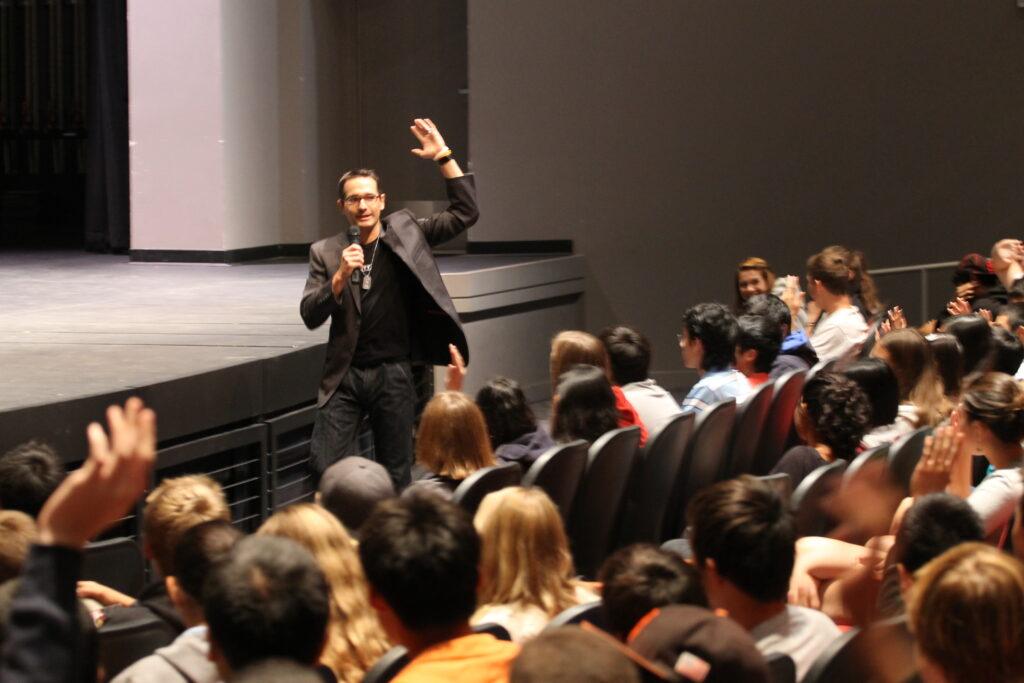The response from the audience was overwhelming. “Nothing!"
On Oct. 5, the freshman class attended an assembly in the McAfee Center during part of fourth period and tutorial for Teen Truth Live, a program aimed at improving the school environment and the way students treat each other.
The program began with a movie about the Columbine shooting, a documentary about two students who brought firearms on campus and killed 13 people and injured many more.
After sharing a personal anecdote, the presenter began interacting with the students, asking them to share what they could do to help solve the issue of bullying on and off campus.
Students who are now sophomores and juniors saw the presentation last year.
“We were pretty impressed with the program, student response was good, and that’s why we decided to bring them back this year,” assistant principal Kevin Mount said.
According to freshman Anne Rollinson, she and her peers were inspired by the assembly.
“I learned that even a small comment can have a major effect on someone and we should really watch the way we treat one another,” Rollinson said.
To Rollinson, one part of the program was especially moving.
“My favorite part of the assembly was when everyone stood up if they had been bullied and then when he asked if we had ever bullied anyone, then everyone sat down,” Rollinson said. “It was really powerful.”
Mount also felt that the parent viewing, presented the night before the freshman showing, was successful.
“I think we had somewhere between 80-100 people there, which was impressive [for] a Thursday night, for parents to come out and participate in something like that,” Mount said. “The feedback we’ve gotten from parents is all positive.”
Hopes for change
Mount believes the assembly will help to correct problems the administration has observed on campus.
“We’re constantly dealing with little issues around how students treat each other, and our hope was that by being proactive and bringing someone in to raise awareness, it might help to address some of [these] things,” Mount said. “Teen Truth Live is another piece of our overall program to try and create a positive culture here.”
Mount hopes that students will be inspired to end some of the problems on campus, such as “spreading rumors, accusing students of doing things for which they have no proof [and] saying nasty things about other people.
“I think it happens more often than we know, and I think what we’re seeing is an increase of students beginning to report these incidents,” Mount said. “Part of what we’ve done is we’ve raised awareness.”
The administration is optimistic that students will work to help eliminate this kind of behavior from campus, Mount said.
“What we’re asking students to do is stand up and say ‘No, we’re not going to treat each other in that way,’” Mount said. “We really want to engage students and help them understand that they are the solution. You’ve got to stop treating people poorly, and our actions really have an effect on other people.”
A program that empowers
This year’s presenter, Erahm Christopher, is a co-founder of Teen Truth Live, director of the films and the writer the presentations.
“Our goals are pretty simple,” Christopher said. “Number one is to give youth a voice, number two is to challenge students to think differently about the issues and [number three] is to empower them to use that power to make a positive impact on their own lives and the lives of others.”
Christopher believes that the films he uses in the presentation play a big role in sending out the group’s message.
“Our program is different because everything we’ve created is created by students. Our films are shot by students, [and] presentations have interaction with the students,” Christopher said. “We really try to make sure that it’s raw, and it’s real. All of our speakers have personal truths that they overcame, so none of our speakers are telling someone else’s story.”
Christopher said he knows the program has made a difference when its message influences students.
“My favorite part of the program is the change that happens in the students during interactions and the discussions, when they start to think differently about the issue of bullying and the impact that students have on each other,” Christopher said.
For Christopher, the main message that he hopes to leave behind is the importance of students taking responsibility for the school’s environment.
“At the end of the day, I will leave the community, and it’s really the community, the students, who need to take home ownership of it,” Christopher said. “I really hope that will happen here.”































